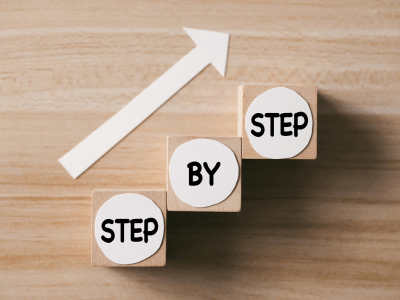It’s exciting and validating when a small business owner realizes their company has boomed, outgrown the small business category, and transitioned to a medium-sized business. As a business grows, so do its website needs. Transitioning a WordPress website from a small business platform to one that supports a larger operation might seem overwhelming, but it doesn’t have to be. Here’s how to ensure your WordPress website scales smoothly and effectively with your medium business growth.
Recognize the Need for Growth
There may have been a time when having nothing more than an About page and a contact form was sufficient. However, once a small business has grown into a medium-sized one, it’s clear that its digital presence must evolve. If that sounds like your current journey, it’s time to recognize the need for the transition and take proactive steps to address it.
Key Considerations for Scaling Your Website
 While recognition of your business growth is important, planning is key. Don’t dive into new growth without first dipping a toe into the water. Here are some things to consider.
While recognition of your business growth is important, planning is key. Don’t dive into new growth without first dipping a toe into the water. Here are some things to consider.
Budget and Timeline
When planning your website upgrade, setting a realistic budget and timeline is crucial. First, find a WordPress developer willing to break your project into phases, allowing for gradual improvements that align with your budget. Second, developing a well-structured timeline ensures a smooth transition without rushing and compromising quality.
Analyze Your Website’s Performance
With increased traffic comes the need for better performance. Slow load times can drive potential customers away, so optimizing your website’s speed is crucial. Use tools like Google PageSpeed Insights to identify and resolve performance issues. Consider upgrading to a more robust hosting plan to handle increased traffic and provide a better user experience.
Accessibility and Scalability
Ensure your website is accessible to all users, including those with disabilities. Implement inclusive design practices, such as providing alt text for images, using appropriate heading structures, and ensuring keyboard navigability. Accessibility not only enhances user experience but also improves your site’s SEO. Choose a platform and design that allows easy scalability, enabling your site to grow with your business.
Steps to Scaling Your WordPress Website
Now that you’ve completed some analysis, it’s time to plot your next steps. Here are some ways to level up your WordPress from small biz to medium biz.
Redesign Your Website
 An updated design is more than just aesthetics; it’s about functionality and user experience. If your website still resembles the relevant design trends when you first launched, it’s time for an update. A modern design can attract bigger clients and make navigation easier for a broader audience.
An updated design is more than just aesthetics; it’s about functionality and user experience. If your website still resembles the relevant design trends when you first launched, it’s time for an update. A modern design can attract bigger clients and make navigation easier for a broader audience.
- User-Friendly Navigation: Ensure visitors can easily find what they’re looking for.
- Responsive Design: Make sure your site looks great and works well on every device.
- Professional Aesthetics: Invest in high-quality graphics and a cohesive color scheme representing your brand.
Improve Performance and Security
As your business grows, ensuring your website performs well and remains secure is paramount. Once you’ve analyzed your website’s performance, improve it.
- Optimize Loading Times: Use tools like Google PageSpeed Insights to fix slowdowns.
- Upgrade Hosting: Move to a more robust hosting plan to handle increased traffic.
- Enhance Security: Implement SSL certificates, regular backups, and security plugins.
Integrate eCommerce Functions
Adding eCommerce capabilities can open new revenue streams if you’re ready to take your brick-and-mortar shop online.
- Choose the Right Platform: WordPress plugins like WooCommerce integrate seamlessly.
- Make Your Shopping Experience User-Friendly: Simplify and secure the checkout process.
- Manage Inventory: Utilize tools to track stock and orders efficiently.
Incorporate Customized Features
Your website should reflect the unique nature of your business. Customized features can enhance user experience and set you apart from the competition. Here are a few ideas:
- Custom Forms: Tailor forms to gather specific information from clients.
- Interactive Elements: Add live chat, customer portals, or interactive maps.
- Personalized Content: Use data to show relevant content to individual visitors.
Adopt an Iterative Web Development Approach
 Scaling your website doesn’t have to be a massive, one-time overhaul. Taking an iterative approach can be more manageable and budget-friendly. Pro tip: not every WordPress development agency offers iterative web development. Before hiring anyone, ask in advance if this type of strategy is possible.
Scaling your website doesn’t have to be a massive, one-time overhaul. Taking an iterative approach can be more manageable and budget-friendly. Pro tip: not every WordPress development agency offers iterative web development. Before hiring anyone, ask in advance if this type of strategy is possible.
- Plan in Phases: Break the scaling process into manageable stages.
- Prioritize Needs: Start with critical updates and gradually implement additional features.
- Monitor and Adjust: Regularly review the impact of changes and make necessary adjustments.
Conduct a Website Audit
Not sure where to start? A comprehensive website audit can identify what needs to be done. An audit evaluates your site’s performance, design, security, and functionality, providing a roadmap for scaling.
Partner with Experts Who Understand How to Use WordPress for Medium Business Growth
Tailoring WordPress for medium business growth is a journey best taken with experts. Work with a design and development team that can guide you through the process. You can create a website that supports your growth by redesigning your site, improving performance and security, integrating eCommerce functions, and incorporating customized features.
Remember, an iterative approach and a thorough website audit will help you manage this process efficiently and effectively. Your WordPress website is a critical digital marketing asset—do all you can to protect and enhance it as your business grows. Contact WebDevStudios for assistance.
Comments